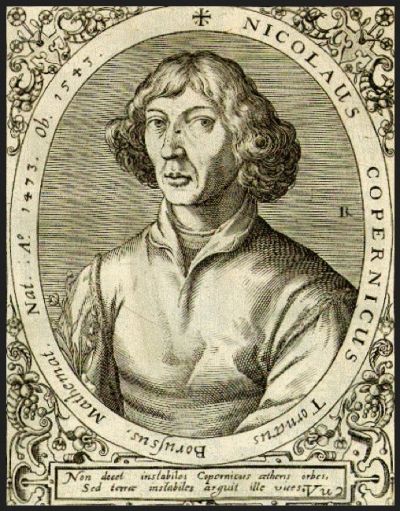Nicolaus Copernicus

“Boring!" was how the 11-year-old Julia described the arguments of her fellow Polish students when they were discussing the nationality of the major astronomer Nicolas Copernicus. “It makes no difference whether he was a German or a Polish citizen!” she continued and buried her nose in her history book, happy that everyone – Germans and Poles alike – could feel proud about Copernicus’s achievements. Now that we seem to have cleared up the question about his nationality we can turn to the really interesting facts about Copernicus. Copernicus often thought about how wonderful it would be to be able to turn his hobby into a profession. But during his lifetime astronomy was not a recognised profession. Hence he worked on his revolutionary idea of stopping the movement of the sun and substituting it by setting all the planets (including the planet Earth) in motion in the cellar of his house in his birthplace, Thorn
Nicholas Copernicus was born on 19th February 1473. After the early death of his father, his uncle Lucas Watzenrode, a Prince Bishop in Warmia, cared for the small boy. At the age of 18 Nicolas Copernicus began to study mathematics in Kraków, followed by medicine and law in Bologna, and Church Law in Ferrara. During his studies he discovered his passion for geography and astronomy. In 1495 Copernicus was given the post of canon in the Cathedral in Frombork (East Prussia). He later took on the duties of a top ranking expert administrator, and was also the governor of Mehlsack and Allenstein. He defended the interests of the Bishop of Warmia at meetings of the Prussian regional government, in Sejm (Poland) and at the court of the King of Poland. In addition Copernicus was the author of a study on reforming the minting of coins, and a successful medical doctor. In Frombork he began work on his major scientific publication "De revolutionibus orbium coelestium" (On the Revolutions of the Heavenly Spheres). Given his many duties it is no surprise that Copernicus researched and honed down his heliocentric theories for a period of 30 years.
In Copernicus’ time science had been dominated for over 1000 years by the ideas of the astronomer Ptolemy, whose geocentric philosophy claimed that the Earth was the fixed point in the centre of the universe and that all other planets including the sun and the moon revolved around it. Copernicus’ revolutionary heliocentric philosophy was that the sun was at the centre of the universe, that the Earth and the other planets revolved around it in circular orbits, and that the Earth turned around its own axis. Copernicus’s observations and calculations also helped people to understand the system of time. The Earth turned around its axis once a day and around the sun once a year. Copernicus only completed his revolutionary work that he wrote in both Latin and German, in 1530. But he waited for over 10 years before he decided to publish it, presumably because he was afraid that he would be scorned by other scholars. But as a mathematician he knew very well that not all his calculations exactly corresponded to his observations. This was also a reason for him to wait. That said, he was much more concerned about how the church, in whose service he stood, would react to his revolutionary thoughts. The Lutheran pastor Andreas Osiander was presumably also aware of a possible conflict and played down the importance of the work in his foreword to "De revolutionibus orbium coelestium". (Copernicus was not aware of his comments at the time). "De revolutionibus orbium coelestium" finally appeared in 1543 in Nuremberg shortly before the death of its author .
"De revolutionibus orbium coelestium" was a complicated work both from an astronomical and a mathematical point of view. It was initially only accessible to a small circle of experts. The first edition attracted great attention all over Europe and was soon available in all the most important libraries around the continent. In 1616 the Roman Catholic Church decided to censor sections of the book containing Copernicus’s heliocentric view of the world, either by changing the text or cutting it entirely. In 1757 the Catholic Church finally ended its ban on the distribution of Copernicus’s findings and in 1822 the Inquisition removed "De revolutionibus orbium coelestium" from the Index. Today "De revolutionibus orbium coelestium" by Nicholas Copernicus is recognised as one of the milestones of modern astronomy and is a key work in the so-called Copernican turn.
By the way the 11-year-old Julia was right. The endless discussions about Nicolas Copernicus’s nationality were senseless. During his lifetime there was no such concept is nationality. The Holy Roman Empire of German nations and the Polish Lithuanian Empire, both of which might have come into question with regard to Copernicus, were composed of many different linguistic and ethnic groups. Nicolas Copernicus was a subject of the King of Poland but his home was the German-speaking community in Warmia.
Adam Gusowski, September 2014
____________
* Nicholas Copernicus died in Frombork on the 24th May 1543.







